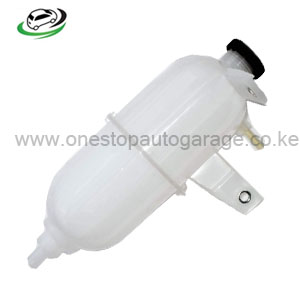-13%
Get Coolant Radiator Reservoir Tank Toyota Hilux Vigo 1KD 2KD
The coolant radiator reservoir tank, often referred to simply as the overflow tank or expansion tank, is a critical component of a vehicle’s cooling system. Its primary function is to manage the level of coolant in the system, accommodate temperature-related expansion and contraction of the coolant, and provide a convenient means for monitoring coolant levels. Let’s delve deeper into its functions and explore the signs that indicate wear or malfunction:
Functions of Coolant Radiator Reservoir Tank:
- Coolant Storage and Overflow:
- The reservoir tank serves as a storage vessel for excess coolant that expands when the engine reaches operating temperature. As the coolant heats up, it expands and flows into the reservoir to prevent over-pressurization of the cooling system.
- Conversely, when the engine cools down, the coolant contracts, and it is drawn back into the radiator from the reservoir to maintain the proper coolant level.
- Coolant Level Monitoring:
- The reservoir tank typically features a transparent or translucent construction, allowing for easy visual inspection of the coolant level. This enables drivers or technicians to check the coolant level without the need to open the radiator cap, promoting safe and convenient maintenance.
- Maintaining the coolant at the recommended level is crucial for optimal engine cooling and preventing overheating.
- Air Bubble Prevention:
- The reservoir tank helps prevent air bubbles or pockets from entering the cooling system. As coolant is expelled into the tank during thermal expansion, it displaces any air present in the system, ensuring that the coolant circulates effectively without the impediment of airlocks.
- This continuous circulation of coolant is essential for maintaining proper engine temperature and preventing overheating.
- Temperature Regulation:
- By providing additional coolant volume, the reservoir tank assists in regulating engine temperature. It helps stabilize coolant temperature by accommodating thermal expansion during engine operation and contraction during cooling cycles.
- This function is critical for preventing both overheating and overcooling of the engine, ensuring optimal performance and longevity.
Signs of Malfunction:
- Coolant Leaks:
- A common sign of a worn-out or damaged reservoir tank is coolant leaks. Cracks, punctures, or deterioration of the tank material can lead to coolant seepage or puddles forming underneath the vehicle.
- Coolant leaks not only result in coolant loss but can also contribute to engine overheating if left unaddressed.
- Visible Damage or Deterioration:
- Inspecting the reservoir tank for visible signs of damage is crucial. Cracks, bulges, or degradation of the plastic material may indicate wear or deterioration.
- Damage to the reservoir tank can compromise its structural integrity and effectiveness in managing coolant levels, necessitating replacement to ensure proper cooling system function.
- Low Coolant Level:
- A sudden or consistent decrease in coolant level within the reservoir tank may indicate a leak or malfunction in the cooling system.
- If the coolant level drops below the recommended range despite refilling, it suggests a potential issue with the reservoir tank or other components of the cooling system requiring inspection and repair.
- Overheating:
- A malfunctioning reservoir tank can contribute to cooling system problems, such as inadequate coolant supply or air pockets forming in the system. These issues may result in engine overheating, characterized by elevated temperature gauge readings or steam emitting from the engine bay.
- Addressing overheating promptly is crucial to prevent engine damage and costly repairs.
- Discolored Coolant:
- Contaminants or debris accumulating in the reservoir tank can cause discoloration of the coolant. A brown or muddy appearance may indicate internal tank corrosion or the presence of engine oil, necessitating inspection and corrective action.
- Clean coolant is essential for effective heat transfer and engine cooling.
- Cracked or Loose Connections:
- Inspecting the connections, hoses, and clamps associated with the reservoir tank is essential. Cracked, loose, or deteriorated connections can lead to coolant leaks or improper sealing, compromising cooling system function.
- Damaged connections should be repaired or replaced promptly to prevent coolant loss and maintain system integrity.
Follow us on Facebook



